
Monitoring microservices is crucial for understanding how apps are functioning and identifying issues to prevent system failures in advance. Let’s take a look at some of the microservices monitoring challenges here!
With Microservices architecture becoming the de facto standard for web applications now, constant monitoring, effective debugging and anomaly detection has become quite important. But, as monolithic applications become distributed across microservices and software teams face pressures while shipping new features and experiences, it becomes extremely challenging to understand performance and identify issues & bottlenecks.
Here are some of the challenges your team might face during the monitoring of microservices, here in this blog! Let’s take a look!
Microservices instead of a Monolith!
By adopting a microservice architecture, a typical monolith application is broken into individual components. Each of these components runs its own programming language and database being deployed, scaled and upgraded independently.
Uber reported in late 2014: with 4,000 proprietary microservices and a growing number of open source systems that needed to be monitored, posed a challenge for monitoring their complex microservices system.
The Real Challenge: An increase in the number of discrete components you need to monitor makes it difficult to manage the system.
Cloud Native Architecture and Kubernetes!
Cloud Native architectures, based on containers and Kubernetes, are popularly being used for running microservices. But its widespread growth has augmented complexity in the process of monitoring of microservices. With cloud-native architecture and Kubernetes, teams need to monitor applications spanning multiple containers, pods, and namespaces, potentially over fleets of clusters.
Besides this, the container’s framework adds to the monitoring task as it becomes a crucial part of the system. Teams now need to monitor Kubernetes cluster metrics, node metrics, pod, and container metrics, as well as Kubernetes’ own control plane services.
The Real Challenge: In containerized workloads, DevOps & SRE teams have to monitor multiple layers and dimensions including infrastructure metrics, Kubernetes & containers metrics and application metrics.
Integrations with Open-Source and Cloud Services!
While implementing Microservices architecture, there arises a need for integration with Open-source and cloud services. This increases the use of built-in libraries, tools, and frameworks for building software systems, including web servers, databases, and queues. Monitoring microservices architecture consisting of these libraries and multiple third-party frameworks makes it difficult to monitor microservices.
The Real Challenge: Complex integrations with a large and dynamic ecosystem of third-party platforms makes monitoring a daunting and time-consuming task for teams.
Key Takeaway
It’s crucial that DevOps & SRE need to continuously examine the gathered data to find solutions for problems within the app. Also, enterprises must invest and try exploring effective Microservices monitoring tools and practices to overcome these microservices monitoring challenges and get complete observability of the health status and performance of their business applications.
BuildPiper, a popular Microservices monitoring tool, renders complete visibility of the deployment status with in-depth reporting on the reasons for failure, enabling a secured, quick and seamless Microservices deployment. With BuildPiper, DevOps teams can get complete visibility of the deployment status and the pod status after service deployment.
To explore its other interesting features, schedule a demo today!



